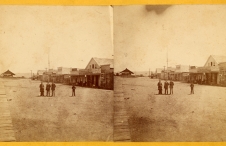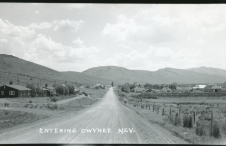Wadsworth
The Wadsworth area was important for settlers as early as 1841, but was not formally established until the railroad arrived. Westbound immigrants, having crossed the Forty-Mile Desert to the east, found the area on the big bend of the Truckee River a welcome place to rest and water livestock. Seasonal trading posts were established by 1854. Wadsworth turned from small settlement to permanent town in 1868, when it was designated as a service station and headquarters for the Central Pacific Railroad's Truckee Division.
By 1883, the town had become an important supply and maintenance station for the railroad. Wadsworth also was a freight and trading center for outlying mining camps, as well as to the agricultural community of Stillwater. A fire destroyed most of the town in 1884. But Wadsworth was rebuilt, and by 1900 supported a population of 1,309.
Citing outdated structures and another destructive fire, railroad officials moved service facilities, thirty miles to the west in 1904. The event greatly reduced the population of Wadsworth, with railroad employees moving their families–and, in some cases, houses–to the new location just east of Reno. The move resulted in the formation of Sparks, which immediately sprang to life.
Because Wadsworth is on the Pyramid Lake Indian Reservation, its history is closely connected to the Native American community. Wadsworth was established on land set aside for the Paiutes before the railroad arrived. Some sources say the borders of the reservation were ambiguous at the time, but it is generally accepted that the railroad trespassed through its southern tip. In recent years, the government has been buying homes and ranches in the Wadsworth area in an effort to return land to the Paiute Tribe. The Natchez Elementary School, which serves mostly Paiute Indians, opened in 1972, and construction of a major tribal housing development began in 1977.
The town survives today and some ranches still exist nearby. The S-Bar-S Ranch, which formerly belonged to socialite Helen Marye Thomas, now serves as a training place for agricultural students at the University of Nevada. In 2000, the population was 881.



